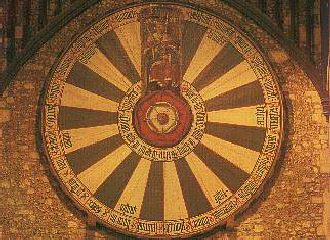 |
 |

The Winchester Round Table
[Tuesday - 05/11/99] Accounts differ about the origin of the Round Table, at which Arthur's knights met to tell of their deeds and from which they invariably set forth in search of further adventures. The Norman chronicler Wace was the first to mention it in his Roman de Brut (1155 AD). There, he simply says that Arthur devised the idea of a round table to prevent quarrels between his barons over the question of precedence. Another writer, Layamon, adapted Wace's account adding the description of a quarrel between Arthur's lords which was settled by a Cornish carpenter who, upon hearing the problem, created a portable table which could seat 1,600 men. Both Wace and Layamon cite Briton story-tellers as their source for this and there is little reason to doubt them. This being the case, the origins of the table could well date back to Celtic times and may even be traceable to the age of Arthur himself. In the later medieval stories, though, it is Merlin who creates the table. Malory, taking up the theme, made the Round Table the centerpiece of his epics.
The large wooden table which hangs in the Great Hall at Winchester dates from between 1250 and 1280 AD, when it may have been made for King Edward III (1272-1307), a king living at the height of chivalry and whom we know to have been fascinated by legends of Arthur. Originally, the table had twelve legs and a large central support. It is 5.5m (18ft) in diameter, 8cm (3in) thick, weighs 1.25 tons, and was formed out of 121 separate pieces of oak. A late fifteenth century chronicle mentions the table as "hanging" at Winchester. When the legs were removed, a raised rim was added and battens nailed to the back to prevent distortion.
The table remained unpainted until the time of Henry VIII when, in 1552, he entertained Charles V, the Holy Roman Emperor. It depicts 24 places, named after the greatest of Arthur's knights. The topmost place is reserved for Arthur himself, though the likeness is actually Henry VIII! The Tudor colors of green and white are used and a Tudor Rose was added at the center as a reminder of the claims made by the Tudor dynasty of descent from Arthur.
The Great Hall itself is the only remaining part of the medieval castle which was not only a fortress, but a royal residence, used regularly by the kings of England throughout the Middle Ages. The present building dates from the early thirteenth century but it was William the Conqueror who fortified the site originally in 1067.
|
Last modified on Wednesday, November 26, 2008 URL: http://www.housecorvus.org/tab.htm Copyright © 1999, 2000-09 House Corvus. All rights reserved. Design and hosting by Bran Trefonnen. | |